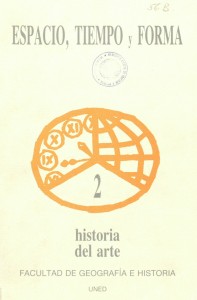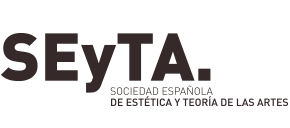El cuarto número de Espacio, Tiempo y Forma. Serie VII. Historia del Arte, Nueva Época acepta artículos en español, inglés y francés tanto para la sección de Miscelánea como para el Dossier temático. Fecha límite de recepción de original: 31de Octubre de 2015.
 CALL FOR PAPERS: ESPACIO, TIEMPO Y FORMA. SERIE VII. HISTORIA DEL ARTE. 2016 – N.4 (NUEVA ÉPOCA)
CALL FOR PAPERS: ESPACIO, TIEMPO Y FORMA. SERIE VII. HISTORIA DEL ARTE. 2016 – N.4 (NUEVA ÉPOCA)
DOSSIER TEMÁTICO: «ART MOVES: PERFORMATIVITY IN TIME, SPACE AND FORM»
por MIEKE BAL
«El arte (se) mueve: performatividad en el tiempo, el espacio y la forma» es el título del dossier temático que acompañará al cuarto número de la revista, que recientemente ha entrado en una nueva época. La coordinadora invitada es Mieke Bal, profesora de Análisis Cultural en la Universidad de Ámsterdam, quien ha propuesto para este número especial el siguiente marco temático/
Nos interesa el arte porque obra cosas en nosotros. Su performatividad puede darse por sentada. Pero ¿qué es exactamente lo que hace el arte y en qué ámbitos existenciales? La afirmación «el arte se mueve» busca reflejar tanto la performatividad del arte sobre sus bases espaciales y temporales como el modo en que el arte se abre paso a través de la forma. El caso más obvio, aunque no el único, es el de la imagen en movimiento. El arte opera de forma performativa en el espacio, pues las artes visuales existen y funcionan en él y, por tanto, influyen en el lugar en que se inscriben: por ejemplo, en una exposición de obra visual fija ―cuadros o dibujos― o, de forma más patente, ante una escultura, el visitante camina alrededor de la obra y ve la imagen en movimiento (aunque ese movimiento sea el suyo propio). Si ésta ejerce sobre el espectador algún tipo de efecto, es decir, si lo «conmueve», es siempre en forma de movimiento espacial. Las imágenes también se mueven en el tiempo: en efecto, las obras de arte se originan en un punto temporal (habitualmente pasado) y, partiendo de éste, dan alcance al espectador en el presente, pero además actúan durante ese momento de encuentro, es decir, en el presente, y orientan los pasos del espectador hacia el futuro. Por fin, las obras de arte actúan emocionalmente sobre el espectador a través de su aspecto exterior, de su forma. En este dossier consideraremos estos tres movimientos de la obra artística en su conjunto, ya sean obras fijas o en movimiento.
Nos interesan artículos originales que acometan la naturaleza móvil del arte desde un punto de vista teórico y mediante el análisis preciso de un caso específico. Se considerarán de especial interés los artículos que traten alguno de estos tres movimientos en particular y tiendan asimismo vínculos con los otros dos. Por ejemplo, resultaría de interés un artículo que estudiara qué ocurre con una obra maestra clásica cuando el análisis se centra en los movimientos de los visitantes de exposiciones de hoy día. Resultarían igualmente interesantes, y sirva de nuevo como ejemplo, artículos que comparasen una imagen en movimiento actual con una imagen fija antigua, o que tratasen aspectos como la composición, el color o la pincelada y los relacionaran con el ritmo, la escala o la materialidad. Esperamos que las aportaciones se centren en ejemplos particulares de cada uno de los tres movimientos y estudien de cerca una obra o bien comparen dos obras entre sí. Las condiciones del movimiento deben quedar perfectamente caracterizadas: el momento y lugar de la ejecución de una obra o el momento, lugar y las circunstancias de su visionado.
Las propuestas serán valoradas y aceptadas de acuerdo con criterios de calidad así como de alcance y variedad.
Rogamos que den la máxima difusión a este Call for Papers. Pueden hacer llegar sus propuestas por medio de la plataforma de nuestra revista electrónica, tras registrarse en la misma y consultar las normas de publicación/
http://revistas.uned.es/index.php/ETFVII
http://revistas.uned.es/index.php/ETFVII/about/submissions#authorGuidelines
Para cualquier consulta o aclaración, pueden dirigirse a la editora de la revista, Inés Monteira serie7.revista-etf@geo.uned.es, y para cuestiones relativas a la plataforma electrónica a Jesús López revista-etf@geo.uned.es
CALL FOR PAPERS: ESPACIO, TIEMPO Y FORMA. SERIE VII. HISTORIA DEL ARTE 2016 – ISSUE N.4 (NEW ERA)
We invite all members of the academic community to submit original manuscripts for the fourth issue of Espacio, Tiempo y Forma. Serie VII. Historia del Arte, New Era. Submissions in English, Spanish and French are welcome for both the collection of articles and the themed dossier. The deadline for submissions is October 31, 2015.
*THEMED DOSSIER: «ART MOVES: PERFORMATIVITY IN TIME, SPACE AND FORM»
By MIEKE BAL
«Art Moves: Performativity in Time, Space and Form» is the title of the themed volume for the fourth issue of the journal that has recently entered a New Era. It will be guest-edited by Mieke Bal, Professor of Cultural Analysis at the University of Amsterdam, who has proposed the following thematic framework for this special issue/
We care about art because it does something to us; hence, its performativity can be taken for granted. But what is it that it does, and in which existential domains? The phrase «art moves» is meant to bring together reflections on the performativity of art in its foundation in space and time, and the way it works through its form, with the moving image as an obvious but not exclusive case. Art works performatively in space, since visual art exists and functions in space, and therefore, also influences the space around it; even in an exhibition of still images such as paintings and drawings, but even more clearly sculptures, visitors walk around and hence, see the images in (their own) movement and if they are affected by them, in other words, moved, this happens in spatial movement. Images also move in time, since artworks not only stem from a time (usually in the past) and reach us from that past in the present, but also function in the time of the encounter, hence, in the present, and orient us towards the future. And, through the way the artwork looks, hence, through its form, it act upon us emotionally as well. In this dossier we will consider the three movements of the artwork together, whether it is a still or a moving work.
We are interested in original papers that address art’s moving quality theoretically and through close analysis of a specific case. We welcome contributions that consider one of these three movements especially, but also in connection to the other two. For example, one can examine what happens with an old master painting when the analysis focuses on the movement of exhibition visitors in the present. Or, a contemporary moving images can be brought into comparison with an older still image. Issues of composition, color and brush strokes may be examined together with rhythm, scale and materiality. We hope that each contribution will focus on a particular example of the three movements, and closely engage one work, or two works in comparison with one another. The conditions of movement must be spelled out, such as time and place of making, and time, place and conditions of viewing.
Proposals will be evaluated and accepted according to quality, but also spread and variety.
Please circulate this Call for Papers widely. Once you have registered and consulted the Instructions for Authors, submit your proposal on our online journal platform/
http://revistas.uned.es/index.php/ETFVII/index
http://revistas.uned.es/index.php/ETFVII/about/submissions#authorGuidelines
If you have any enquiries, please contact the journal editor, Inés Monteira serie7.revista-etf@geo.uned.es; for queries regarding the e-platform, contact Jesús López revista-etf@geo.uned.es.








